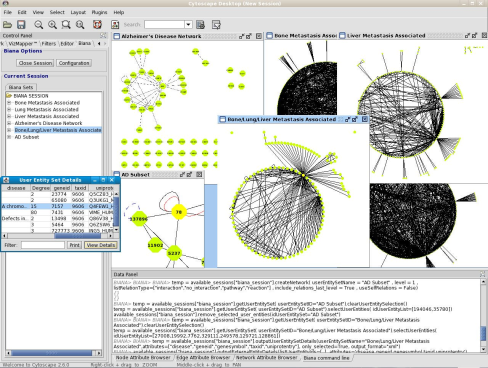BIANA
BIANA: Biologic Interaction and Network Analysis
What is BIANA?
BIANA (Biologic Interactions and Network Analysis) is a biological database integration and network management framework written in Python. It uses a high level abstraction schema to define databases providing any kind of biological information (both individual entries and their relationships). Any data source that contains biologic or chemical data parsed by BIANA is defined as an external database. Similarly BIANA integration approach adopts the concept of external entity, corresponding to entries in external databases. For example, a uniprot entry (a protein), a GenBank entry (a gene), an IntAct interaction (an interaction), a KEGG pathway (a metabolical relation) or a PFAM alignment are all represented as external entities. In order to achieve data uniformity, in the cases where the data repository supplies relations, both participants and relation itself are considered as external entities, whereas the relation itself is annotated as external entity relation which is a subtype of external entity. External entity objects are characterized by several attributes, such as database identifiers, sequence, taxonomy, description or function. Each external entity relation object is further characterized by some attributes like detection method and reliability. Alternatively, the participants in external entity relations can have their particular attributes like role and cardinality. BIANA unifies external data inserted into its database using its parsers based on a specific protocol. This protocol, called unification protocol, consists of a set of rules that determine how data in various data sources are combined (crossed). Each rule is composed of attributes that have to be crossed and the external databases which are going to be used. The set of external entities that are decided to be "equivalent" with respect to a given unification protocol is called user entity. User entities inherit all the attributes of their included external entries. Thus, BIANA utilizes user entries specific to a certain unification protocol chosen by the user. User can either use provided built-in unification protocols or create his/her own unification protocols. As an example, a user may be interested in creating a unification protocol defined by crossing similar sequences and same taxonomy between two or more databases and crossing entities by uniprot accession code. The advantages of this integration approach are: 1) BIANA database only contains raw data (with exactly the same nomenclature and identifiers of the original data source), therefore does not entail any assumption on data integration allowing user to specify how the integration should be done; 2) User can use information from a single database or the combination of multiple databases, selecting which ones he wants to use at each moment; 3) User can know exactly how was the original data, and do a backtracking of his/her integration approach.

